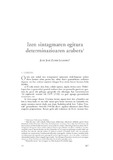Mostrar el registro sencillo del ítem
Izen sintagmaren egitura determinazioaren arabera
| dc.creator | Zubiri Lujanbio, Juan José | es_ES |
| dc.date.accessioned | 2017-11-21T09:10:26Z | |
| dc.date.available | 2017-11-21T09:10:26Z | |
| dc.date.issued | 2000 | |
| dc.identifier.issn | 0046-435X (Print) | |
| dc.identifier.issn | 2530-5832 (Electronic) | |
| dc.identifier.uri | https://hdl.handle.net/2454/26249 | |
| dc.description.abstract | El objetivo principal de este trabajo de investigación consiste en abrir nuevos horizontes de trabajo en el análisis tradicional que se hacía del sintagma nominal (SN), ya que ciertas expresiones del lenguaje hablado (y también del escrito) escapaban a las descripciones habituales y normativas dadas para el SN del euskara. La propuesta se basa sobre todo en la observación de dos variables; por una parte, se detecta el comportamiento de los determinantes del sintagma, y por otra parte, se comprueba el orden de los elementos que conforma dicho sintagma. Ateniéndonos a estas dos variables se propone la siguiente clasificación: 1) sintagmas tradicionales, 2) sintagmas excindidos, y 3) sintagmas con el orden de los elementos alterado. En este trabajo se hace hincapié sobre todo en las dos últimas tipologías. En el caso de los sintagmas excindidos, el elemento que se mueve de su lugar de origen traslada consigo el determinante que le corresponde al sintagma entero. En este tipo de sintagmas, por tanto, existen más de un determinante (que en el parámetro del análisis clásico no ha tenido explicación convincente). En el otro tipo de sintagmas, en cambio, existe un movimiento de los elementos conformantes del sintagma, pero aparece única y exclusivamente un determinante, y no dos como en la tipología anterior, lo que lleva a postular la existencia de otro tipo de sintagmas diferenciados de los anteriores. | es_ES |
| dc.description.abstract | Ahozko nahiz idatzizko hizkeran erabiltzen diren hainbat eta hainbat esapide ohiko ISren egituraren bidez azaltzea ezinezkoa denez, lan honen helburu nagusia bide berriak urratzea eta beste sailkapen bat proposatzea izan da. Lanaldi honi ekiteko, batik bat bi ezaugarriri erreparatu diegu, alde batetik, determinatzaileen agerpenari, eta beste aldetik, sintagmaren barneko elementuen ordenari. Bi ezaugarri hauen arabera honako sailkapen hau proposatzen da: 1) ohiko ISak, 2) izen sintagma bananduak (ISB), eta 3) elementuen ordena aldatua duten ISak. Lanean zehar ISBez, batez ere, eta ordena aldatu duten ISez aritu gara. ISBen kasuan, esan daiteke, oro har, sintagmaren zatiren bat mugitzen denean, mugitutako elementuak berarekin batera garraiatzen duela sintagmari dagokion determinatzailea (cf. txango polita egin genuen –> polita egin genuen txangoa). Horrelako sintagmetan, hortaz, determinatzaile bat baino gehiago agertzen dira. Eta nola jokatzen duten azaltzeaz gain, zer-nolako motak diren ere adierazten da txostenean. Bestalde, elementuen ordena aldatua duten ISen jokabidea aztertzen da; hauetan, sintagmaren barreneko elementuak mugitzen dira, oro har, izenaren eskuinetara, baina determinatzaile bakarra agertzen denez, beste sail batean sartzea proposatzen da. | eu |
| dc.description.abstract | The main aim of this piece of research is to open new working possibilities for traditional noun-phrase analysis, since certain expressions from the spoken (and also written) language are not duly covered by the usual descriptions and rules laid out for the noun phrase in the Basque language. The suggestion is principally based on the observation of two variables: first of all, the behaviour of the determiners in the noun phrase is detected; and second, the order of the parts making up this noun phrase is checked. Basing ourselves on these two variables, the following classification is proposed: 1) traditional sintagmas, 2) split sintagmas, and 3) sintagmas with altered part order. Special attention is paid in the present article to the last two types. In the case of split sintagmas, the part which shifts from its position of origin moves the determiner of the entire sintagma in so doing. More than one determiner exists, therefore, in this type of sintagma (something which classical analysis has been unable to explain satisfactorily). In the other kind of sintagma, however, there is a shift in the parts which go to make up the sintagma, but only one determiner appears and not two as in the type just described, leading us to postulate the existence of another type of sintagmas which are different from the previous ones. | en |
| dc.format.extent | 37 p. | |
| dc.format.mimetype | application/pdf | en |
| dc.language.iso | eus | en |
| dc.publisher | Gobierno de Navarra. Institución Príncipe de Viana | es_ES |
| dc.relation.ispartof | Fontes Linguae Vasconum, 85 (2000), 367-403 | es_ES |
| dc.rights | Creative Commons Attribution-NonCommercial 4.0 International (CC BY-NC 4.0) | en |
| dc.rights.uri | http://creativecommons.org/licenses/by-nc/4.0/ | |
| dc.subject | Sintagma nominal | en |
| dc.title | Izen sintagmaren egitura determinazioaren arabera | eu |
| dc.type | Artículo / Artikulua | es |
| dc.type | info:eu-repo/semantics/article | en |
| dc.contributor.department | Filología y Didáctica de la Lengua | es_ES |
| dc.contributor.department | Filologia eta Hizkuntzaren Didaktika | eu |
| dc.rights.accessRights | Acceso abierto / Sarbide irekia | es |
| dc.rights.accessRights | info:eu-repo/semantics/openAccess | en |
| dc.type.version | Versión publicada / Argitaratu den bertsioa | es |
| dc.type.version | info:eu-repo/semantics/publishedVersion | en |



